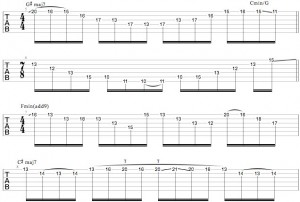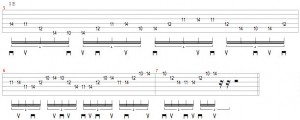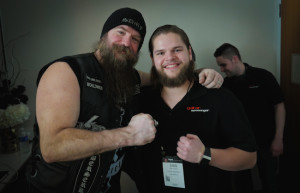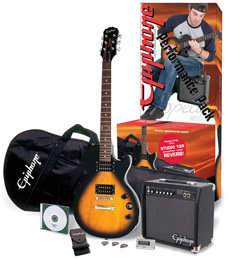Welcome to Guitar Messenger! My name is Paul Wardingham, and I’m going to be showing you how to play some futuristic-themed shred ideas using excerpts from my new album Assimilate Regenerate, as well as a solo written and recorded exclusively for this lesson.
Whenever a student asks me how to play so-called ‘futuristic’ sounding licks, there are certain techniques and scales that always seem to spring to mind when trying to create this sound.
Ex 1. Sweeping Sus2 Arpeggios – Cyber Warfare (4:31)
Example 1 is taken from the last solo in the track ‘Cyber Warfare,’ and uses a sequence of sweep-picked sus2 arpeggios (R,2,5). The lick begins with a descending Esus2 arpeggio and then slides down to an ascending Csus2, up to Esus2, down to Dsus2 and finally a Gsus2 arpeggio with an F# and E added for a nice flavor.
When playing arpeggios with odd groupings of notes per beat, aim to land the first note of each arpeggio pattern on the beat and the rest should fall into place.
Paul Wardingham – Example 1

Ex 2. Wide-Interval Tapping – Futureshock (0:36)
Example 2 shows a wide-interval tapping section from ‘Futureshock.’ The first part shows a repeating melody based on the B Mixolydian mode, using right and left hand tapping and employing hammer-ons from nowhere.
The big string-skipping part at the end uses 5th intervals. The tricky part here is to keep the extraneous open string noise to a minimum when skipping strings, and hammering on with the 1st finger of the left hand. I use the 2nd and 3rd fingers of the left to dampen the open strings where possible.
Paul Wardingham – Example 2
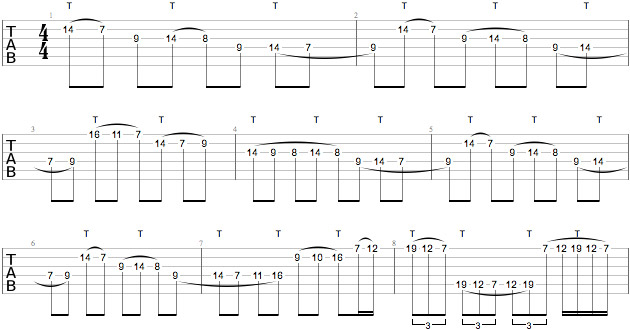
Ex 3. Whole Tone Soloing – Black Hole Device (2:47)
Example 3 from ‘Black Hole Device’ uses one of the more unusual sounding scales in metal, the Whole Tone scale, made up of consecutive whole tones. The first part of the lick uses the basic scale pattern with fast alternate picking, and then moves into ascending augmented arpeggio patterns found within the scale.
The Whole Tone scale is a fun and easy scale to learn due to its symmetrical nature, which enables you to move identical patterns around the fretboard.
Paul Wardingham – Example 3
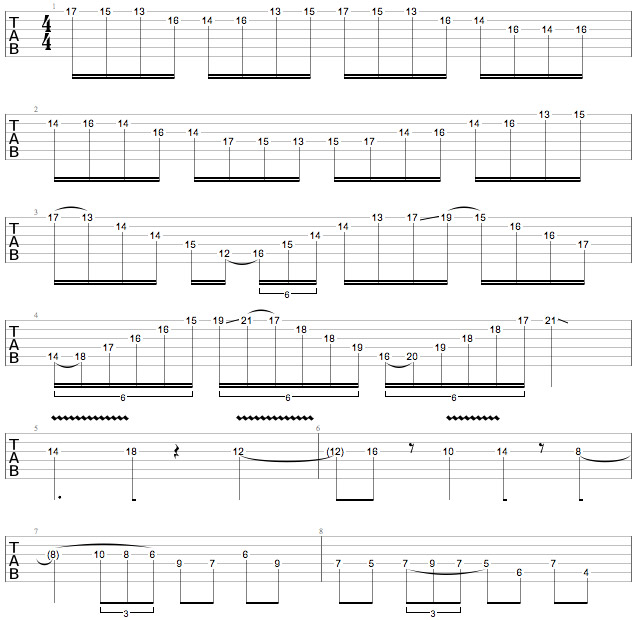
Ex 4. Computer Tapping – Mindwarp (3:02)
Example 4, from ‘Mindwarp,’ uses a technique I call ‘Computer Tapping,’ due to the effect that’s created when it’s played high on the fretboard. The melody is essentially a 7-note pattern repeated 4 times over 2 bars and then the first 4 notes of the pattern are played again before the 2 bars are repeated.
A variation on these bars follows. I use the 1st and 3rd fingers for the left hand taps and the 2nd and 4th for the right hand taps. This lick might prove to be difficult until you’ve built up a bit of strength in your right hand pinky. Note that this example also makes extensive use of hammer-ons from nowhere.
Paul Wardingham – Example 4
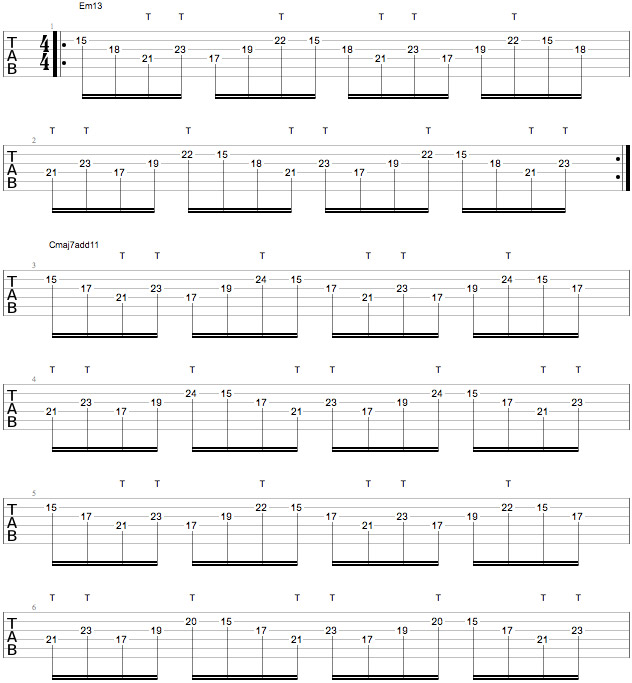
Ex 5. Lydian Dominant Soloing – Futureshock (1:49)
Example 5 is the first half of the first solo from the track ‘Futureshock.’ This solo utilizes one of my favourite ‘futuristic’ sounding scales called Lydian Dominant (R, 2, 3, #4, 5, 6, b7). This scale is most often heard being used by jazz and fusion players over dominant chords, but it can have a more epic, mystical sound for metal that’s very appealing to me. You might also recognize it from the theme tune to The Simpsons.
Bars 1- 4: The solo kicks off with a long legato run, moving up the fretboard using 3-note per string patterns.
Bars 5 – 6: Begins with a legato-tapped majoradd#11, 3 octave arpeggio using 2nd and 3rd fingers for the tapped notes.
Bars 7 – 12: Next is a series of 1-note per string patterns based on diminished 5th intervals. I’m really just searching for interesting ear-catching patterns with this sort of thing rather than thinking about specific arpeggio shapes.
Bar 13 – 16: Begins with a fluid 5-note sweep-picked ascending run. The timing of this lick is a bit unorthodox, and I would suggest, instead of trying to count it, to just try and nail the timing of the start and end note of the run until you hit the Ebmajor arpeggio. To finish off I play a sweep-tapped Emajor7 arpeggio to take us out of Lydian Dominant, leading on to the next solo.
Paul Wardingham – Example 5

Ex 6. Assimilate Reintegrate Solo (approx 42 seconds long)
The following solo, written and recorded exclusively for Guitar Messenger, combines all of the concepts previously demonstrated in this lesson, as well as some new ideas.
Bars 1 – 5: Shows some B Phrygian Dominant usage to start the solo.
Bars 6 – 8: We encounter some speedy legato shred using the Whole Tone scale illustrated in Example 3. The taps on the 21st and 23rd frets are played with the 2nd and 4th fingers of right hand.
Bars 9 – 10: Some wide-interval tapping follows, elaborating on the idea at the end of Example 2 using 5th intervals.
Bars 11 – 12: Shows an idea I use a lot, moving between 2 arpeggios. In this example G and A major arpeggios are used, until the end of Bar 12 where I play a Dsus2 pattern.
Bars 13 – 16: A bluesy lick to break up all the shred moves into a melodic Gmajor/Dadd11 hybrid arpeggio pattern in Bar 15, up to an A major and then a kind of Cmajor9 sweep-tapped arpeggio outlining the change in the riff.
Bars 17 – 22: Lydian Dominant makes an appearance in Bar 18 with a Holdsworth/Howe-inspired descending in 3rds idea. Next we shift between 2 different arpeggios again, this time between B and F and then a string-skipped, spacey sounding Bmajorb13 arpeggio.
Bars 23 – 24: To finish, I use the ‘Computer Tapping’ technique outlining Bm/G/A chords. With this idea, I tend to look for patterns in scales I like the sound of rather than playing specific arpeggios.
Paul Wardingham – Assimilate Reintergrate Solo




